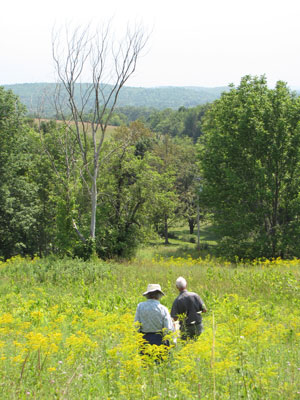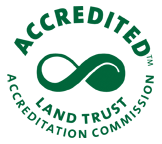 You love your land and want to control what will happen to it after you are gone. Here are some options.
You love your land and want to control what will happen to it after you are gone. Here are some options.
As a landowner, you can partner with Rensselaer Land Trust to preserve your land for future generations in one of two basic ways: Rensselaer Land Trust can acquire the development rights, or Rensselaer Land Trust can acquire ownership.
Conservation Easements Held by the Rensselaer Land Trust
The most common method of land preservation practiced by Rensselaer Land Trust is a conservation easement. A conservation easement is a custom, flexible voluntary legal tool that allows you to permanently protect the land you love. With a conservation easement, you retain many of your property rights and control of how the land is to be used in the future. An easement restricts future activities, especially development, in order to protect the conservation values of your land for perpetuity (legal term for “forever”). Conservation easements are conveyed by deed, have a conservation purpose, and are maintained in perpetuity. They represent a partnership between the owner and the Land Trust, and may only be extinguished by a court of law. Property that is under a conservation easement requires stewardship and monitoring, remains on the tax rolls, can be sold and does not require public access. The easement’s provisions, including those prohibiting development, stay with the land, and all future owners are bound by them.
Easements can by donated or purchased. Rensselaer Land Trust will work with the landowner to prepare an easement that meets his or her needs and interests, while also fulfilling the Rensselaer Land Trust’s conservation objectives. For example, the owner might retain the right to limited subdivision or to manage forests, graze animals, grow crops, or permit public access to the property.
Transfer of Land to the Rensselaer Land Trust
An owner may wish to transfer title of his/her land to the Rensselaer Land Trust. Transfer can take place immediately or in the future, in one of the following ways:
- Donation, including gift or bequest. A donation may be spread out over time, for example a portion each year for several consecutive years. Rensselaer Land Trust is a tax‐exempt organization and therefore donations and bequests are tax deductible as allowed by law.
- Purchase at less than market value, also called a “bargain sale.” In this instance, the difference between the sales price and an independently determined appraisal value of the property may be tax deductible.
- Purchase at market value. No tax deduction.
Most often, land acquired by the Rensselaer Land Trust is held permanently by Rensselaer Land Trust and opened to the public as a nature preserve. Other options, pursuant to the wishes of the landowner, include transfer to another qualified conservation organization, to a government entity, or to an individual; or the land can be used as trade lands—the property is sold and the proceeds used for the protection of a property with greater public benefit.
Rensselaer Land Trust can take full title to the land, or it can acquire land with “less than full title” where the owner retains certain specified legal rights to the property even as property ownership is transferred to Rensselaer Land Trust. Examples of such retained rights include rights to water or timber, access to the property, life estates, and right of reversion (i.e., return of title to the owner if terms of donation are not met). Land donors may set deed restrictions on how the land is used by the Land Trust in the future.
For more information, see the Overview of Common Methods of Land Conservation.



